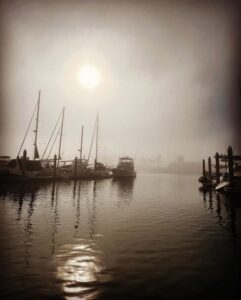by Nella Nelson
 Ventura’s fog often rolls in during May and lingers well into July, giving rise to the familiar terms “May Grey” and “June Gloom.” Sometimes the fog burns off by afternoon, while other times, the marine layer persists, turning into a light drizzle that clings to the coast throughout the day. On particularly dense fog days, windshield wipers are a must during early mornings or late evenings.
Ventura’s fog often rolls in during May and lingers well into July, giving rise to the familiar terms “May Grey” and “June Gloom.” Sometimes the fog burns off by afternoon, while other times, the marine layer persists, turning into a light drizzle that clings to the coast throughout the day. On particularly dense fog days, windshield wipers are a must during early mornings or late evenings.
The simple explanation is that inland heat causes an increase in coastal fog, commonly known as our marine layer. William Patzert, a retired climatologist with NASA’s Jet Propulsion Laboratory, explains, “The marine layer develops offshore, where low clouds form as air sinks over the cold ocean water. A contrast in temperature—between hot inland air and cool ocean air—tends to draw the marine layer onto land. The bigger the contrast, the stronger the marine layer moving onshore.”
During the summer, the cooling effect of the marine layer attracts visitors from inland areas, eager to escape the scorching temperatures.
“In everything from kayaks to large boats, you’ve got to go slow and use your equipment to avoid a collision,” advises John Higgins, Ventura Harbor’s Harbormaster.
The familiar “boop boop” sound echoing across the ocean and fields is the comforting call of Ventura’s foghorn, located at the tip of the south jetty.
“It’s basically just a raised stick on a horn with a red marker,” says Brendan Donohue of the Ventura Harbor Patrol. Interestingly, the foghorn can be activated by the public. Boaters can tune to VHF Channel 81 and “cue it five times,” Donohue instructs, “and it will sound for half an hour.”
But how foggy is Ventura compared to other places? According to the Farmers’ Almanac, Point Reyes, California, takes the top spot with 200 foggy days per year, where visibility is often reduced to mere feet. The foggiest place in the world is Grand Banks, Newfoundland, which endures 206 days of dense fog annually, thanks to the collision of the chilly Labrador Current with the Gulf Stream. In comparison, Ventura averages 92 foggy days per year, according to Business Forward Ventura County—putting our fog into perspective.
Ventura Harbor’s microclimate tends to gather most of the area’s fog, as the shore cools it immediately. So, the next time you hear the fog horn’s signal, remember the inland heat you’re happily escaping.
Sources:
- “Why Is There So Much Fog Lately in Ventura County?” by Gretchen Wenner, Ventura County Star, August 17, 2019.
- “5 Foggiest Places in North America,” Farmers’ Almanac.
